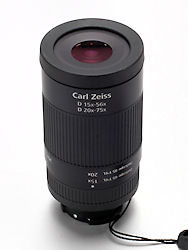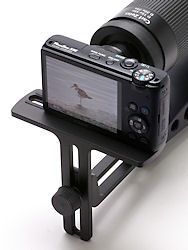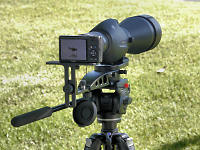Zeiss DiaScope 85 T* FL Spotting Scope
|
|
Review Highlights
- New
fully-locking 20-75x Vario eyepiece
- Very
bright, sharp, high-contrast images
- Innovative
dual-speed focusing
- Excellent
digiscoping options
- Complete
rubber armoring - needs no case
|
The Zeiss Victory DiaScope
85 T*FL spotting scope… Okay, that’s what Zeiss calls it
officially and it makes us tired just to type it all in. On the other
hand, we will never get tired of looking through this beautiful scope.
We’ll just come up with shorter names for it! The 85-mm Zeiss DiaScope
(see?!) was re-designed and released in April of 2010 but for some reason,
we never got one in to play with until quite recently, a fact we began
to regret as soon as we began using it in the field. Victory FL 85 scopes
come in both straight and angled configurations, and are now available
only in black – gone are the moss green and silver versions. Make
no mistake, this re-design was a major overhaul and what was already an
excellent spotting scope is now significantly better, thanks to a new
eyepiece, better image performance and excellent digiscoping options.
Brightness
and Clarity
When you think of the brand
name “Zeiss Victory FL”, you should immediately think of amazingly
bright images provided by that fluoride glass. We reviewed both straight
and angled models equipped with the new Vario D 20-75x zoom eyepiece.
Zeiss literature claims that a large improvement in image quality was
achieved by design changes that minimized stray light, resulting in improved
contrast. That’s hard to verify, but what we can say is that the
image quality is superb: bright and sharp at dawn and dusk or under overcast
conditions. At first you don’t notice it, because when you are using
it, you tend to focus only on what you are seeing. Then you take your
eye away from the eyepiece and realize with a start how dark it’s
gotten… and how late you are getting home! The image quality is
dangerously seductive! The brightness of the DiaScope 85 comes into play
if you plan on viewing anything at dusk or dawn, peak activity times for
nature watchers, but it is also a major factor in photography (see below).
Glass
and Coatings
 The heart of the optical system is the fluoride glass, which helps reduce
the splitting that occurs as light passes through the lenses and prisms.
The fluoride glass helps to focus all the light wavelengths on the same
plane, yielding sharper images with more zing. To this, Zeiss adds their
proprietary T*multicoating, for enhanced light transmission and greater
color fidelity. Lastly, Zeiss adds their LotuTec® coating which makes
the lenses shed water more rapidly, as well as repelling dirt and making
cleaning them easier. As noted above, the total system provides image
quality that is difficult to match.
The heart of the optical system is the fluoride glass, which helps reduce
the splitting that occurs as light passes through the lenses and prisms.
The fluoride glass helps to focus all the light wavelengths on the same
plane, yielding sharper images with more zing. To this, Zeiss adds their
proprietary T*multicoating, for enhanced light transmission and greater
color fidelity. Lastly, Zeiss adds their LotuTec® coating which makes
the lenses shed water more rapidly, as well as repelling dirt and making
cleaning them easier. As noted above, the total system provides image
quality that is difficult to match.
Eyepieces
A quick discussion of the eyepieces
for Zeiss DiaScopes is in order. Zeiss makes three eyepieces for their
Victory FL spotting scopes: two zoom (Vario) eyepieces and a fixed magnification
eyepiece. The eyepieces fit both the 65- and 85-mm DiaScopes, but yield
different magnifications and variably-sized fields of view depending upon
which scope they are mounted on – data below are all for the 85-mm
versions. Eyepieces attach via a standard bayonet mount that now truly
locks in place, an improvement from the old DiaScopes.This one is really
well executed.
| Eyepiece* |
Magnification |
Field of View at 1000
yds |
Eye Relief |
Weight |
| Vario |
20-75x |
120-48 feet |
16 mm |
18.3 oz. |
| Vario |
20-60 |
129-60 |
16 mm |
12.0 oz. |
| Fixed |
40x |
90 feet |
18 mm |
8.1 oz. |
The new eyepieces will fit
old DiaScopes, but won’t lock on them. Likewise, old eyepieces will
fit the new DiaScopes, but again won’t lock. All Zeiss scope eyepieces
feature eyecups that adjust with a simple twist-out mechanism. There is
even a stable position between fully in and out, marked by a subtle detent.
The mechanism is gradual and offers sufficient resistance that virtually
all positions of the eyecup are remarkably stable. We never had one collapse
in the field in all our hours of field testing, which is excellent performance
in this regard. One last note on eyepieces: Zeiss themselves recommend
the 20-75x eyepiece for use in digiscoping.
Physical
Properties
 The
85-mm Victory FL scopes weigh 4 lbs, 6 oz. and the eyepiece add another
18 oz. This is a factor to take into account when selecting a tripod –
you will want something sturdy and significant to stabilize and protect
your investment. The straight DiaScope 85 is about 18 inches long with
the 20-75x eyepiece in place (the angled model is ~1 inch shorter). The
tripod mounting bracket has a standard thread mount and an anti-twist
pin socket. Like virtually all scopes today, Victory DiaScopes have the
tripod-mounting bracket attached to a ring within which the body of the
scope rotates. The scopes can rotate +/-135° off vertical with detents
every 45°. The chassis are very solid, with rubber armoring protecting
the entire optic. All Zeiss DiaScopes are completely sealed to render
them water- and dust-proof, and nitrogen-purged to prevent internal fogging.
The lens hood is black and slides out quite easily but stays in place
well in the field. The lens hood has a molded-in sighting device to aid
in aiming the scope at a desired target. Zeiss did something else we really
like and see far too little of: they engineered thread mountings for filters
or adapters into the barrel end of the objective lens. This allows the
use of a UV filter to prevent the objective lens from getting scratched.
Filters are much cheaper to replace than scopes!
The
85-mm Victory FL scopes weigh 4 lbs, 6 oz. and the eyepiece add another
18 oz. This is a factor to take into account when selecting a tripod –
you will want something sturdy and significant to stabilize and protect
your investment. The straight DiaScope 85 is about 18 inches long with
the 20-75x eyepiece in place (the angled model is ~1 inch shorter). The
tripod mounting bracket has a standard thread mount and an anti-twist
pin socket. Like virtually all scopes today, Victory DiaScopes have the
tripod-mounting bracket attached to a ring within which the body of the
scope rotates. The scopes can rotate +/-135° off vertical with detents
every 45°. The chassis are very solid, with rubber armoring protecting
the entire optic. All Zeiss DiaScopes are completely sealed to render
them water- and dust-proof, and nitrogen-purged to prevent internal fogging.
The lens hood is black and slides out quite easily but stays in place
well in the field. The lens hood has a molded-in sighting device to aid
in aiming the scope at a desired target. Zeiss did something else we really
like and see far too little of: they engineered thread mountings for filters
or adapters into the barrel end of the objective lens. This allows the
use of a UV filter to prevent the objective lens from getting scratched.
Filters are much cheaper to replace than scopes!
Focusing
The Zeiss DiaScopes employ
a new dual-speed focusing system in which both the coarse and fine focus
are combined in one knob. When you first move the focus knob, it is in
fine mode, with approximately a third of a turn in either direction. Moving
the knob continually in either direction engages the coarse or rapid focus.
The focus mechanism has a fairly shallow pitch, requiring just over six
full turns of the focus knob to go from minimum close focus to infinity.
The coarse focus is intentionally stiff, while the fine focus is much
smoother. For people used to a standard dual focus knob system, this dual
focusing mechanism takes a little getting used to. We polled a number
of people on the subject, and found nearly an even split: some liked it
and some didn’t. What we can tell you is that you get used to it
fairly quickly, and soon you don’t notice anything different. While
we’re on the subject, Zeiss lists their minimum close focus for
the 85-mm FL scope at 16.25 feet, but we easily achieved sharp focus at
just 14.25 feet. That statistic will vary with the user, but it is excellent
performance for a full-sized scope on this property. Minimum close focus
becomes quite important when digiscoping.
Digiscoping
 Zeiss does support several types of digiscoping options for the DiaScope
85. An SLR camera can be attached using a
standard T2 ring. They also marketed the Quick Camera Adapter II for positioning a standard point-and-shoot
digital camera behind the scope eyepiece. The Quick Camera Adapter II
fits both the angled and straight configurations with adjustment of a
single set-screw. This adapter is designed solely to fit Zeiss spotting
scopes. The scope mounts on the adapter by screwing it directly into the
tripod-mounting bracket. The entire assembly is then mounted on a quick-release
plate to connect to a tripod. The adapter is designed to swing out of
the way to allow the scope to be used for normal viewing. A spring-loaded
pin locks the system when the camera is in place, but it can be set in
non-locking mode to allow quick switching to viewing mode. Like all digiscoping
systems, mastering this one takes practice, but we found ourselves getting
decent shots right away (insert photo example). More to the point, digiscoping
is governed by the quality of the optic. At least with a scope of this
quality, truly excellent photos are readily obtainable – it’s
just up to you to execute.
Zeiss does support several types of digiscoping options for the DiaScope
85. An SLR camera can be attached using a
standard T2 ring. They also marketed the Quick Camera Adapter II for positioning a standard point-and-shoot
digital camera behind the scope eyepiece. The Quick Camera Adapter II
fits both the angled and straight configurations with adjustment of a
single set-screw. This adapter is designed solely to fit Zeiss spotting
scopes. The scope mounts on the adapter by screwing it directly into the
tripod-mounting bracket. The entire assembly is then mounted on a quick-release
plate to connect to a tripod. The adapter is designed to swing out of
the way to allow the scope to be used for normal viewing. A spring-loaded
pin locks the system when the camera is in place, but it can be set in
non-locking mode to allow quick switching to viewing mode. Like all digiscoping
systems, mastering this one takes practice, but we found ourselves getting
decent shots right away (insert photo example). More to the point, digiscoping
is governed by the quality of the optic. At least with a scope of this
quality, truly excellent photos are readily obtainable – it’s
just up to you to execute.
Conclusions
The Zeiss Victory DiaScope
85 T*FL spotting scopes are usually sold as body-only or in combination
with the Vario zoom eyepiece. Currently, Zeiss is offering a variety of
special bundles that include a scope body, an eyepiece and a tripod.
| Scope Body |
Eyepiece |
Tripod |
Price |
| Angled |
20-60x |
Aluminum |
$3,249.99
|
| Straight |
20-60x |
Aluminum |
$3,249.99
|
| Angled |
20-75x |
Aluminum |
$3,399.99
|
| Straight |
20-75x |
Aluminum |
$3,399.99
|
| Angled |
20-75x |
Carbon Fiber |
$3,698.99
|
| Straight |
20-75x |
Carbon Fiber |
$3,698.99
|
The aluminum tripod is the
one we field-tested for this review and it’s a decent tripod without
too many frills or extras. At this price, the aluminum tripod is, literally,
free. The carbon fiber tripod raises the price of the bundle $400 relative
to the aluminum one, but this is a Manfrotto tripod/head combination that
would normally sell for $600 just by itself. The angled and straight configurations
cost the same:
$2,599.99
for the body only or
$3,249.99
when in combination
with the 20-75x Vario zoom eyepiece. The Vario eyepieces are sold separately
at $799.99
for the 20-75x eyepiece and
$649.99
for the 20-60x model, while
the 40x fixed eyepiece costs $450.00 by itself. In today’s scope
market place, there is a bewildering variety of makes and models to choose
from, and you make your choice based on a number of different factors
including size and weight, optical quality, photographic capability and
price, or combinations of thereof. When you choose a Zeiss DiaScope 85,
it is immediately evident that optical quality is what matters to you
most, and anyone who sees you carrying one will know that automatically.
The 85-mm DiaScopes offer an intoxicating mixture of unsurpassed brightness,
razor sharp image quality and elegant design. You can’t get much
more out of a scope than that.
This scope has been discontinued and Zeiss has released a new series, the
Victory Harpia Spotting Scopes,
which come in 85mm and 95mm angled models. We expect to review the Harpias
once supply catches up with demand.